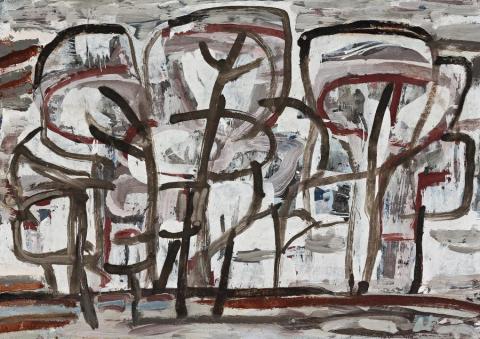FOREST, 1959
IAN FAIRWEATHER
gouache and synthetic polymer paint on cardboard
37.0 x 52.0 cm
signed with initials lower right: IF
Ruth Prowse collection, Canberra
Niagara Galleries, Melbourne
Private collection, Melbourne
Ruth Prowse: Thirty Years of Collecting, Drill Hall Gallery, Australian National University, Canberra, 1 April – 16 May 2004
Blue Chip XVII – The Collectors' Exhibition 2015, Niagara Galleries, 28 April – 30 May 2015, cat. 23 (label attached verso)
Ian Fairweather, Niagara Galleries, Melbourne, 29 April – 24 May 2014, cat. 5 (label attached verso)
Ruth Prowse: Thirty Years of Collecting, Drill Hall Gallery Publications, Canberra, 2004, p. 34
Forest, 1959, synthetic polymer paint and gouache on cardboard on composition board, collection National Gallery of Victoria
After years of nomadic wanderings, Ian Fairweather finally settled in 1953 on Bribie Island, a scrubby, ragged island north of Brisbane. Building a primitive studio-shack out of driftwood and scrap, he set about 'transform(ing) impressions of his surroundings and memories into complex, layered works.'1 Continuously informed by Chinese art and literature, his painterly marks and lines revealed a deeply responsive and expressive connectedness to his surroundings, noting that 'the Chinese have quite a different idea of painting from us. The movement, the stroke of the hand counts so much for them. They never draw a straight line. And it's the same for me. It's given me a sensitiveness towards line that I didn't have.'2 By the late 1950s, these densely orchestrated paintings were becoming more and more abstract, culminating in a series of pure abstractions from 1958 to 1960.
Forest, 1959 is a companion to the larger painting of the same name and date, in the collection of the National Gallery of Victoria. Painted in tones of ochre, oxide and Fairweather's favourite Reckitt' s Blue, Forest depicts the everyday scene that confronted the artist as he wandered his island home. The full force of his Chinese studies is on display with repetitive swirls indicating the canopy and bare verticals for the trunks and branches. In spite of the flatness of its depiction, a subtle sense of distance still pervades, articulated through the diminishing scale of the arcs. Materials never mattered much to Fairweather and the 'gouache' used by the artist was 'actually Fairweather's own, described by (biographer Murray) Bail as his 'use of dry pigments mixed with unknown binders'.3 Happily, 'in mid-1958 (Fairweather) began experimenting with plastic paint, to the relief of the nation's curators, conservators and collectors',4 and Forest, 1959 is painted in this manner. Photos from Bribie Island also show the artist's haphazard method of nailing artworks to his studio wall as he painted, evidence of which may be found on this painting as well.
Ian Fairweather is rightly recognised as one of the most individualistic artists ever to work in Australia and in spite of his preferred isolation, many notable identities made the pilgrimage to Bribie Island to meet him. Right from the start, Fairweather's paintings had an influential impact on other artists following their first public display in Melbourne at Cynthia Reed's gallery in 1934. The art critic Robert Hughes famously camped overnight to purchase a painting from an exhibition opening at Macquarie Galleries in 1961, and two years later, the publisher Mervyn Horton chose the abstract Painting X for the first cover of Art and Australia.
1. Goddard, A., 'Ian Fairweather: the Bribie years', Ian Fairweather: late works 1953-74, QAGOMA, Brisbane, 2012, p. 19.
Some major paintings have up to 70 layers of paint.
2. Fairweather, I., 1968. Interview with Craig McGregor, quoted in: Bail, M., Fairweather, Murdoch Books, Sydney, 2009 (revised edition), pp. 269-270
3. Carter, A., 'Conservation notes', Ian Fairweather: late works 1953-74, QAGOMA, Brisbane, 2012, p. 90
4. Bail, M., Fairweather, op. cit., p. 156
ANDREW GAYNOR
